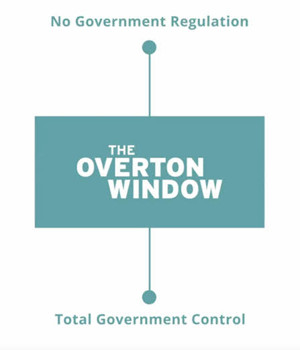Overton Window

An example of the Overton Window on the spectrum of government control. Many policies fit inside the blue area, and that area might move over time toward either end of the spectrum.
(Credit: Taken from a video at the Mackinac Center for Public Policy)
This is a range of things that are considered acceptable to society or an organization at any point in time.
Things in the “middle” of the Overton Window are very mainstream. As policies or customs get more esoteric, they might get to the edges of the Overton window, in which they’re considered maybe odd or questionable, but still acceptable. Things outside the Overton Window are considered unacceptable.
The window moves, generally towards liberal policies and behavior. What might have been outside the window at one time, can move to just inside the edge of the window, and then to the mainstream.
For example, homosexuality was once clearly outside the Overton Window. But the window moves slowly, and homosexuality began to be more accepted – the window moved to encompass homosexuality at its edge. In the 70s and 80s, some people were openly gay, and it was acknowledged and understood, but not talked about. In the 90s and 2000s, homosexuality became more and more accepted by mainstream society. Today – for most of the American public – homosexuality is somewhere squarely within the Overton Window.
It was named for Joseph Overton who worked at the Mackinac Center for Public Policy. He applied the window to politics, claiming that politicians will support or deny policies based on where they think the policy falls in relation to the Overton Window.
The Mackinac Center for Public Policy has a helpful video which explains the concept. On that same page, they also have an interactive slider showing how the window might move in relation to a subject like education policy.
Why I Looked It Up
The concept is a favorite of theologian and pundit Doug Wilson. For example, in a November 2021 blog post he was discussing how the world is shifting Christians’ consideration of what’s acceptable.
And over time, this is how the Overton Window moves. If you are extremely reluctant to discipline outliers to your left, and have no problem disciplining your outliers to the right, then the organization as a whole is going to move steadily left.
For the record, he was not happy about this.
Searching for “overton” on his website turns up many usages.